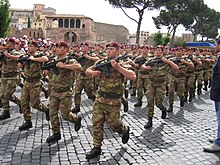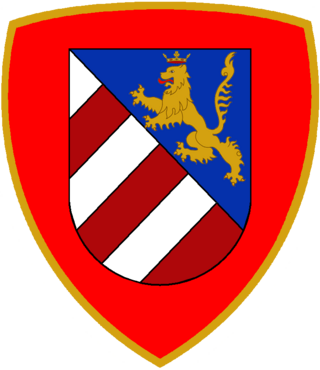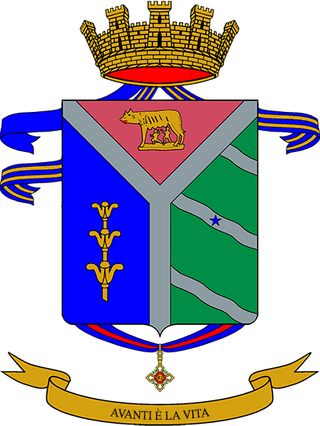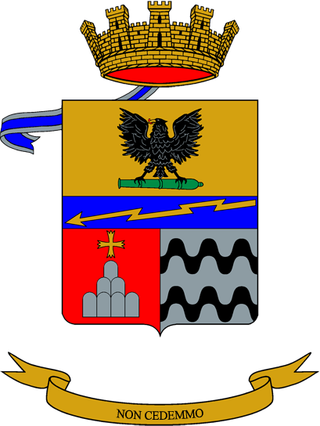
The Paracadutisti (English: Paratroopers ) are a speciality of the Italian army's infantry corps.

The Paracadutisti (English: Paratroopers ) are a speciality of the Italian army's infantry corps.
The first Italian paratroopers were trained shortly before World War II at Castel Benito near Tripoli in Libya, where Italy's first Parachuting School was located. The first paratroopers were two battalions of Libyan Ascari del Cielo. [1] These were joined the first paratroopers of the Royal Italian Army and the 1st Carabinieri Paratroopers Battalion. The latter battalion was formed on 1 July 1940 and fought in the Western Desert Campaign of World War II. The Royal Italian Air Force also had paratrooper units.
In 1941 the staff at Castel Benito was transferred to Tarquinia near Rome where the main Italian Parachuting School was raised, which immediately began to form the first units for the 185th Infantry Division "Folgore".

A second Parachuting School was established in Viterbo and the 184th Infantry Division "Nembo" was raised. A third division, the 183rd Infantry Division "Ciclone" was in the process of forming but the Armistice of Cassibile and the following German invasion of Italy interrupted its organization.
In 1941 the 5,000-man strong 185th Infantry Division "Folgore" was raised for the planned assault on Malta in Operation Hercules. When the Malta invasion was cancelled the paratroopers were sent as regular infantry to Libya, despite being poorly equipped for this role. The division was engaged in ground combat operations in the Western Desert Campaign from July 1942 until its destruction in the Second Battle of El Alamein. After the battle the survivors were grouped into the CLXXXV Paratroopers Battalion.
During the Second battle of El Alamein the division was attacked by six British divisions (two armored and four infantry). Lacking effective anti-tank weapons, the Italian paratroopers stopped British tanks with their obsolete 47/32 guns and petrol bombs. The Folgore, having run out of water, withdrew from the El Alamein at 2:00 a.m. on 3 November 1942. At 2:35 p.m. on 6 November what was left of the division was surrounded by the British forces. The exhausted paratroopers destroyed their weapons and then surrendered.
The 184th Infantry Division "Nembo" was raised in 1942. In summer 1943 the Nembo was sent to Sardinia, where it survived the Armistice of Cassibile almost intact. Shipped to the Italian mainland in May 1944 the division joined the Italian Liberation Corps of the Italian Co-Belligerent Army. The division fought in the battle Battle of Ancona and was disbanded on 24 September 1944 to form with its personnel the Combat Group "Folgore".

The 183rd Infantry Division "Ciclone" was planned to become the third Italian paratroopers division, however the Armistice of Cassibile and disbanded by the invading Germans.
A number of paratroopers units were raised by Mussolini's Italian Social Republic:

In 1982 the Folgore brigade landed in Beirut with the Multinational Force in Lebanon. In 1991, a Paratroopers Tactical Group was deployed to Kurdistan. Its mission was to provide humanitarian aid. From July 1992, the Folgore supplied personnel to Operation Vespri Siciliani. From 3 December 1992 to September 1993 the Folgore participated in Operation Restore Hope in Somalia. Parts of the Folgore have been employed many times in the Balkans (IFOR/SFOR in Bosnia and KFOR in Kosovo), with MNF in Albania and INTERFET in East Timor. The Folgore participated from August 2005 to September 2005 in Operation Babylon in Iraq and was last deployed to Afghanistan in December 2014.
In August 2007, the Folgore took part in United Nations Interim Force in Lebanon, under aegis of the United Nations (Resolution 1701), as a result of the war between Israel and Hezbollah of summer 2006.

The Paratroopers Brigade "Folgore" is an airborne brigade of the Italian Army. Its core units are three battalions of paratroopers (paracadutisti). The name "Folgore" is Italian for lightning. The Folgore is one of three light infantry brigades of the Italian Army. While the Folgore specializes in parachute operations its sister brigade in the Division "Vittorio Veneto" the Airmobile Brigade Friuli specializes in helicopter assault operations. The Folgore and its units are based in Tuscany, Veneto and Lazio.
The 1st Carabinieri Paratroopers Regiment "Tuscania" is a special operations unit of the Italian Carabinieri. Together with the 7th Carabinieri Regiment in Laives, the 13th Carabinieri Regiment in Gorizia, and the Special Intervention Group it forms the 2nd Carabinieri Mobile Brigade. The regiment is based in Livorno, and has approximately 550 personnel.
185th Infantry Division "Folgore" was an airborne division of the Royal Italian Army during World War II. The division was formed in Tarquinia near Rome on 1 September 1941. In July 1942 the division was sent to Libya to fight in the Western Desert Campaign and was destroyed during the Second Battle of El Alamein in early November 1942.
The 184th Infantry Division "Nembo" was an airborne division of the Royal Italian Army during World War II. After the Armistice of Cassibile the division joined the Italian Co-belligerent Army's Italian Liberation Corps and together with the Polish II Corps liberated Ancona in the Battle of Ancona.
The 211th Coastal Division was an infantry division of the Royal Italian Army during World War II. Royal Italian Army coastal divisions were second line divisions formed with reservists and equipped with second rate materiel. They were often commanded by officers called out of retirement.

The Mechanized Brigade "Gorizia" was a mechanized brigade of the Italian Army. Its core units were mechanized infantry battalions. The brigade's headquarters was in the city of Gorizia and the brigade's units were based in the region of Friuli-Venezia Giulia. The brigade's name was chosen in memory of the World War I Battle of Gorizia. The brigade's sister brigade, the Armored Brigade "Vittorio Veneto", was named to commemorate the World War I Battle of Vittorio Veneto.

The Mechanized Division "Folgore" was a mechanized division of the Italian Army. Its core units were three mechanized brigades. The brigades headquarters was in the city of Treviso.

The 8th Paratroopers Engineer Regiment "Folgore" is an airborne military engineering regiment of the Italian Army based in Legnago in Veneto. The regiment is assigned to the Paratroopers Brigade "Folgore" and combines the lineage and traditions of the Royal Italian Army's 8th Engineer Regiment and VIII Paratroopers Sappers Battalion, and the Italian Co-Belligerent Army's CLXXXIV Mixed Engineer Battalion.

The 185th Paratroopers Artillery Regiment "Folgore is an artillery regiment of the Italian Army, specializing in airborne operations. Originally an artillery regiment of the Royal Italian Army, the regiment was assigned in World War II to the 185th Infantry Division "Folgore", with which the regiment was deployed to North Africa for the Western Desert campaign, during which division and regiment were destroyed in the Second Battle of El Alamein. Reformed in 1975 the regiment is today based in Bracciano near Rome and assigned to the Paratroopers Brigade "Folgore". The regimental anniversary falls, as for all Italian Army artillery regiments, on June 15, the beginning of the Second Battle of the Piave River in 1918.
The Italian Liberation Corps was a corps of the Italian Co-belligerent Army during the Italian campaign of World War II. After the announcement of the Armistice of Cassibile on 8 September 1943 the Italian government began the formation of units to fight on the allied side against Germany. On 18 April 1944 the Italian Liberation Corps was formed, which after an intense cycle of combat operations was disbanded on 24 September 1944 to form division-sized combat groups.

The 2nd Carabinieri Mobile Brigade, based in Livorno, is the Carabinieri formation dedicated to military missions abroad, including military police tasks. It employs the 7th Carabinieri Regiment "Trentino-Alto Adige", the 13th Carabinieri Regiment "Friuli-Venezia Giulia", the 1st Parachute Carabinieri Regiment "Tuscania" and the Gruppo di intervento speciale.

The 185th Paratroopers Reconnaissance Target Acquisition Regiment "Folgore" is an Italian Army special forces unit. The regiment is part of the Italian Army's infantry arm's Paracadutisti speciality and assigned to the Army Special Forces Command. The regiment was formed in 1941 as 1st Paratroopers Regiment and assigned, in September 1941, to the Paratroopers Division. The division was intended to parachute onto Malta during the planned invasion of Malta. In July 1942, the invasion of Malta was postponed indefinitely and the Paratroopers Division was ordered to deploy to North Africa as reinforcement for the German-Italian Panzer Army Africa. Consequently, the division, which would operate as an infantry formation in North Africa, was renamed on 27 July 1942 185th Infantry Division "Folgore". On the same day, the 1st Paratroopers Regiment was renamed 185th Infantry Regiment "Folgore". When the division moved to North Africa the regiment remained in Italy and in September 1942, the regiment left the division. On 1 November 1942, the regiment joined the 184th Infantry Division "Nembo" and was renamed 185th Infantry Regiment "Nembo". In May 1943, the 184th Infantry Division "Nembo" was ordered to deploy to the island Sardinia and once again the regiment did not accompany the division, but was instead sent to Apulia and then to Sicily.

The 183rd Paratroopers Regiment "Nembo" is a paratroopers unit of the Italian Army based in Pistoia in Tuscany. The regiment is part of the Italian Army's infantry arm's Paracadutisti speciality and assigned to the Paratroopers Brigade "Folgore".

The 186th Paratroopers Regiment "Folgore" is a paratroopers unit of the Italian Army based in Siena in Tuscany. The regiment is part of the Italian Army's infantry arm's Paracadutisti speciality and assigned to the Paratroopers Brigade "Folgore".

The 187th Paratroopers Regiment "Folgore" is a paratroopers unit of the Italian Army based in Livorno in Tuscany. The regiment is part of the Italian Army's infantry arm's Paracadutisti speciality and assigned to the Paratroopers Brigade "Folgore".

The 182nd Armored Infantry Regiment "Garibaldi" is an inactive unit of the Italian Army last based in Sacile in Friuli-Venezia Giulia. The regiment was part of the Italian Army's infantry arm and was last assigned to the Infantry Division "Folgore".

The 184th TLC Support Battalion "Cansiglio" is a telecommunications (TLC) support battalion of the Italian Army's signal corps. The battalion is based in Treviso in Veneto and assigned to the Army Logistic Command. The unit was formed in 1947 as a battalion and assigned to the Infantry Division "Folgore". In 1976, the battalion was named for the Cansiglio Pass and received the number 184th, which had been used by the 184th Connections Company that had served with the 184th Infantry Division "Nembo" and the Combat Group "Folgore" during the Italian campaign of World War II. With the name and number the battalion also received its own flag. In 1993, the battalion was disbanded and its personnel used to form the Signals Materiel Repair, Supply and Experimentation Telematic Center. In 1999, the center was renamed 184th TLC Support Regiment, which received the flag and traditions of the battalion. Since then, the unit is responsible for building and maintaining the army's telecommunications network in northern Italy and Tuscany, and for providing third line maintenance for the network's materiel in the aforementioned regions. In 2017, the regiment was disbanded and the battalion became once more an autonomous unit. The battalion's anniversary falls, as for all signal units, on 20 June 1918, the day the Austro-Hungarian Army began its retreat across the Piave river during the Second Battle of the Piave River.
183rd Infantry Division "Ciclone" was a short-lived airborne division of the Royal Italian Army during World War II. The Ciclone began to form in summer 1943 at the Parachute School in Viterbo and by the end of summer four battalions had been trained.
The 184th Paratroopers Regiment "Nembo" is a unit of the Italian Army based in Livorno in Tuscany. Formed in 1942 and during World War II the regiment is part of the Italian Army's infantry arm's Paracadutisti speciality. On 1 October 2022, the regiment's name, flag, and traditions were assigned to the Command and Tactical Supports Unit "Folgore" of the Paratroopers Brigade "Folgore".

The 184th Artillery Regiment "Nembo" is an inactive field artillery regiment of the Italian Army, which was based in Gradisca d'Isonzo in Friuli-Venezia Giulia. Originally an artillery regiment of the Royal Italian Army, the regiment was assigned in World War II to the 184th Infantry Division "Nembo", which was Italy's second paratroopers divisions. After the announcement of the Armistice of Cassibile the division and regiment joined the Italian Liberation Corps and fought on the allied side in the Italian campaign. In 1944 the regiment joined the Combat Group "Folgore" of the Italian Co-belligerent Army and was assigned to the British XIII Corps. During the Cold War the regiment was assigned to the Infantry Division "Folgore" and from 1976 the Mechanized Division "Folgore". The regiment was disbanded in 1996. The regimental anniversary falls, as for all Italian Army artillery regiments, on June 15, the beginning of the Second Battle of the Piave River in 1918.